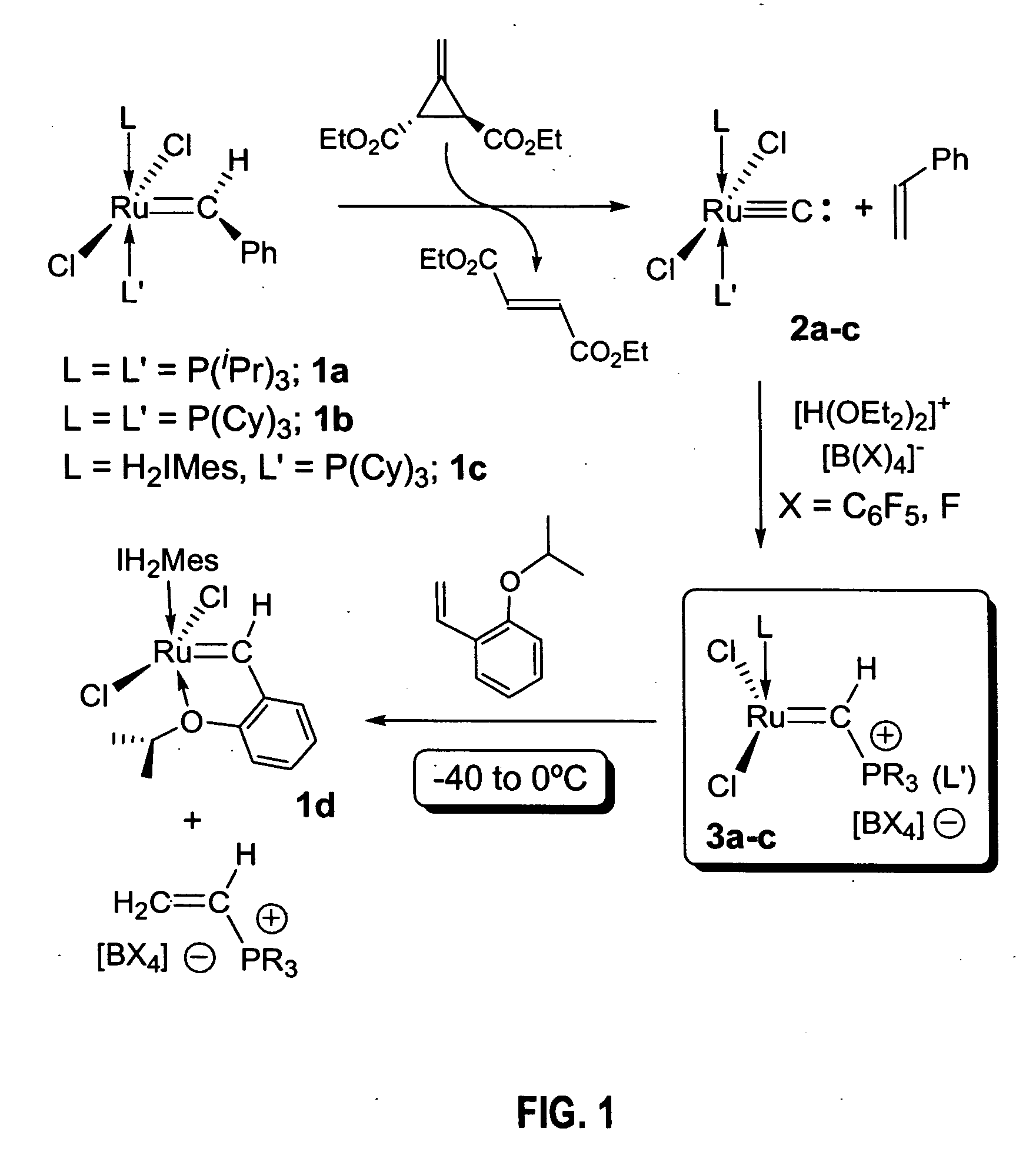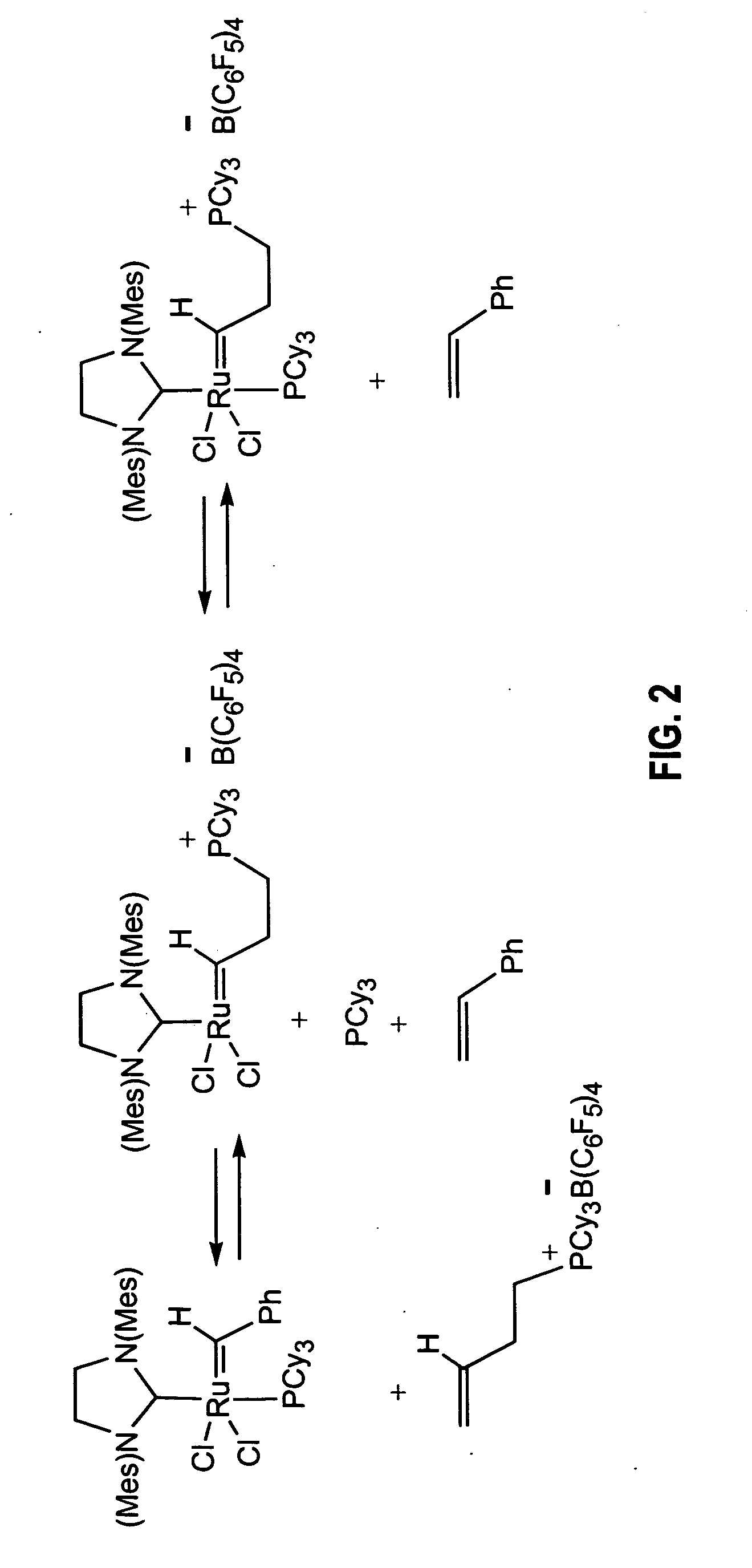Transition metal carbene complexes containing a cationic substituent as catalysts of olefin metathesis reactions
- Summary
- Abstract
- Description
- Claims
- Application Information
AI Technical Summary
Benefits of technology
Problems solved by technology
Method used
Image
Examples
example 1
Preparation of (i-Pr3P)2Cl2Ru═C: (2a)
[0118] In the glovebox, a 50 mL round bottom flask equipped with a stir bar was charged with (i-Pr3P)2Cl2Ru═CHPh (1a, 1.00 g, 1.71 mmol), which was dissolved in ca. 15 ml of dry CH2Cl2. To this solution, 0.291 g (1.71 mmol) of Feist's ester dissolved in ca. 5 ml of CH2Cl2 were added at once via pipette with stirring. Within 1 minute, the color of the solution changes from purple to brown; stirring was continued for additional 20 minutes. The flask was then connected to a vacuum line and the solvent removed to dryness. Drying was continued for ca. 30 additional minutes to remove most of the styrene by-product. The flask was then opened to air and the solid residue was transferred to a sublimation apparatus, where the majority of the flumarate by-product was removed at 50-60° C. under dynamic vacuum for 1.5 hours. At this point some traces of organic material might remain (Feist's ester, styrene or fumarate, all 1H NMR (CD2Cl2, 25° C.): d 1.43 (dd...
example 2
Preparation of (Cy3P)2Cl2Ru≡C: (2b)
[0119] Using a procedure similar to the one outlined for 2a in Example 1, 2b was obtained in 90-95% yield. Spectral parameters matched those previously reported (i.e., by Carlson (2002) J. Am. Chem. Soc. 124:1580).
example 3
Preparation of (H2IMes)(Cy3P)Cl2Ru≡C: (2c)
[0120] In the glovebox, a 50 ml round bottom flask equipped with a stir bar was charged with (H2IMes)(Cy3P)Cl2Ru═CHPh (1c, 1.50 g, 1.76 mmol), which was dissolved in ca 20 ml of dry CH2Cl2. To this solution, 0.300 g (1.76 mmol) of Feist's ester dissolved in ca. 10 ml of CH2Cl2 were added at once via pipette with stirring. By contrast to the preparations of 2a-b, no immediate visible change was observed and the solution was stirred overnight (separate NMR experiments indicated that at this concentration, the reaction takes ca. 4 hrs. to reach completion). Work-up procedures were identical to those described above for 2a-b, resulting in a brown solid corresponding to pure carbide 2c was obtained. Yield: 1.22 g (90%).
PUM
| Property | Measurement | Unit |
|---|---|---|
| Polarity | aaaaa | aaaaa |
| Structure | aaaaa | aaaaa |
Abstract
Description
Claims
Application Information
 Login to View More
Login to View More - R&D
- Intellectual Property
- Life Sciences
- Materials
- Tech Scout
- Unparalleled Data Quality
- Higher Quality Content
- 60% Fewer Hallucinations
Browse by: Latest US Patents, China's latest patents, Technical Efficacy Thesaurus, Application Domain, Technology Topic, Popular Technical Reports.
© 2025 PatSnap. All rights reserved.Legal|Privacy policy|Modern Slavery Act Transparency Statement|Sitemap|About US| Contact US: help@patsnap.com



